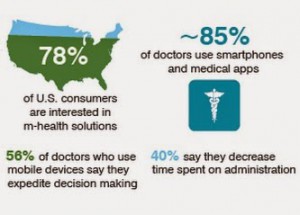Digital
mHealth Explained in Facts

How do patients feel about mHealth?
- 78% of US consumers are interested in mHealth solutions. (Booz & Co.)
- Which is part of the reason the U.S mobile health audience (those looking for health information through mobile web or apps) reached 95 million in 2013—Up 27% from the same point a year earlier. (Manhattan Research)
- 69% of US adults are willing to communicate with providers by email, 49% are interested in communicating via online chat or web portal, 45% by text message and 40% by mobile health applications. (PWC)
- 46% of people indicated they’re interested in using technologies such as smart phones and tablet applications to manage issues such as blood sugar or breathing function in the future. (Deloitte)
- 75% of Americans said they would check their vitals more often if it meant saving money on insurance premiums. (mHealth News)
What about physicians?
- 82% of healthcare professionals use a mobile device for professional reasons at least once daily. (eMarketer)
- 64% of HCPs use medical apps at least monthly. (eMarketer)
- 37% of physicians have already prescribed an app to a patient. (QuantiaMD)
The result:
- Health and wellness apps are growing 87% faster than the app industry as a whole. (Flurry)
- In terms of year over year mobile spend, the pharma industry led the way with a 491% growth in Q1 2014 versus Q1 2013. (Millenial Media)
- In 2014, there are projected to be over 100 million eVisits globally resulting in more than $5 billion in savings over face-to-face visits. (Deloitte)
- The mobile health market is projected to reach $26 billion by 2017. (Mobile Health Market News)
How is the industry reacting?
- More than $750 million in venture capital has been invested in mHealth apps since the start of 2013. (MIT Technology Review)
- There are over 100,000 mHealth and fitness apps currently available for download. (mHealthWatch)
- This year, researchers have developed technology capable of measuring heart rate through Wi-Fi signals with 99% accuracy. This technology has the potential to be used in health tracking apps. (Mobiloitte)
However,
- Only about 7% of people use an app or tool on their phone to track the “health indicator they care about the most”. (Pew Research)
- 36% of healthcare companies currently have no mobile technology strategy. (Robert Half Technology)
- More othan two-thirds who have downloaded a mobile health app have stopped using it. (MIT Technology Review)
- One third of consumers who own wearable health devices stop wearing them after six months. (MobiHealthNews)
What are the issues?
- Compliance: Only 1 in 1,000 mHealth apps are approved by the FDA. (mHealthWatch)
- User Experience: Only 28% of physicians report being “very satisfied” with the quality of medical apps currently available (Booz & Co.). In addition, of this enormous group of health and fitness apps, more than half have generated less than 500 downloads. (iHealthBeat)
- Data Security: 61% of internet users would stop using their favorite mobile health app if a data breach occurred. (HealthIT Security)
